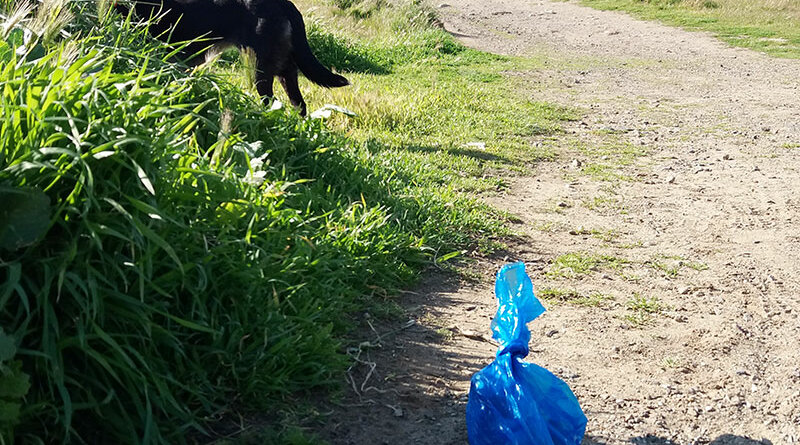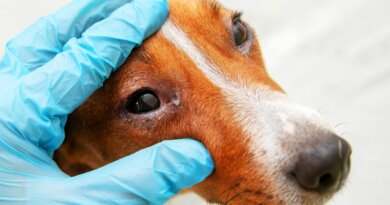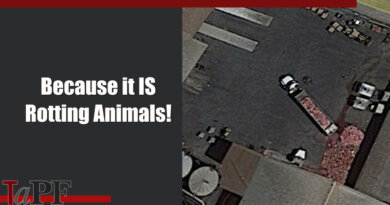The Problem with Dog Poop Bags
Douglas firs line the popular trails up to Spencer Butte in Eugene, Ore. Hikers making their way to the rocky pinnacle can glimpse the bright-red heads of pileated woodpeckers hammering tree trunks in search of insects, and tiny golden mushrooms spreading across fallen logs. They’re also likely to see dozens of plastic dog-poop bags lining the trails, and sometimes, even dangling from tree branches.
Over the past year, pandemic-weary people and their pups have flocked to hiking trails across the country. But the prevalence of dog-lovers outdoors seems to have translated into a flood of colorful little bags left everywhere. In January, a ranger hiking Devil’s Backbone Open Space in Colorado picked up 47 dog-poop bags that people had neglected to pack out. In Oregon’s Forest Park, another ranger collected 52 bags in less than a mile. Hikers in Virginia’s Shenandoah National Park cram bags into plastic brochure holders on posts, while those roaming trails near Boston toss bags into the trees.
Ugliness aside, abandoned dog poop pollutes the soil and spreads bacteria; a child playing in sand or dirt near or contaminated by dog feces can spread salmonella or E. coli to the whole family. Not to mention other health threats to dogs, wild animals and people, including giardia and parasites such as roundworms, hookworms and cryptosporidium. The mess can also contaminate rivers and lakes, causing algae blooms and supporting invasive plants that crowd out native plants and fish. Dog poop may be “natural,” but that doesn’t make it harmless.
Consequently, park rangers are working overtime to scoop left-behind poop, assisted by volunteers who may or may not even own a dog.
GET THE BARK NEWSLETTER IN YOUR INBOX!
Sign up and get the answers to your questions.
A threat to the environment and tourism
Oregon park ranger Simon Freeman patrols the beach and trails at Cape Lookout State Park near Tillamook. He’s noticed an increase in both tourism and the number of abandoned dog-waste bags since the start of the pandemic, though bags left on trails were an issue previously as well.
“Everybody wants to come out and enjoy some fresh air after being cooped up for so long,” he says, “but there’s a lack of facilities that would normally be open, such as public bathrooms, and not as many places for people to throw away their dog-waste bags. So they leave them on the beach or near signs for beach access.”
This is problematic, he explains, because marine mammals and birds may mistake the brightly colored bags for a food source (such as jellyfish) and ingest them, which can potentially be fatal. Humans are also negatively affected by feces left on the ground. “It can take up to a year for dog waste to fully decompose,” he says. “The bacteria gets into the watershed, which can cause all sorts of issues. Plus, it’s highly acidic and bad for plants.”
Useful Tools
• DooDoo Tube. Portable container locks in odors and attaches to a leash or fits in a backpack.
• PooVault. Soft- or hard-shelled containers in a variety of sizes; they contain odors and attach with a carabiner or belt clip.
• Tailgate Dumpster. Magnetic silicone wastebasket attaches to the back of your car and holds dog poop bags until you get home.
• Or, DIY it. An empty tennis-ball or other sport-ball container is lightweight and spacious. The lid prevents unwanted odors. Upend the container over a garbage can and you’re good to go!
In 1991, the Environmental Protection Agency labeled dog waste a pollutant. The waste produced by just 100 dogs in a few days, they announced, can contain enough bacteria to close a bay and its surrounding areas to swimming and shellfishing. “It’s a problem across the entire U.S.,” Freeman says. “All it takes is a quick Google search, and you’ll see state and local governments having the same issues we see out here on the coast and throughout Oregon.”
Part of Freeman’s job is to pick up marine debris so that people can have an enjoyable experience on the coast. Sometimes—particularly over the Fourth of July—he loses count of how many dog waste bags he’s gathered. “It can be a lot,” he says. “Five-gallon bucketsfull, sometimes.”
He and other Oregon park rangers educate people about the negative effects of dog waste on both the environment and on visitors—many of whom can only vacation at the coast once a year. “It can be disheartening for us at times,” he says. “We take a lot of pride in being able to offer these amazing public lands, and we want to provide a good visitor experience for everyone.”
Mitigating the problem
Education is key, says Dave Sutherland, retired education coordinator for the City of Boulder’s Open Space and Mountain Parks. Over 24 years, he participated in several campaigns aimed at mitigating the problem. The department installed dispensers with compostable dog poop bags at 19 trailheads, as well as receptacles designed to turn the poop into potting soil for non-edible plants. Another campaign encouraged hikers to pick up their own dog’s poop as well as “orphan” poops.
People want trash cans every 100 or so feet along a trail, but that would require double the park staff to maintain the cans, explains Sutherland. The solution, he says, lies in picking up and carrying the dog-waste bag with you on your hike. “Most people are well meaning; they plan to pick up their bag on their return,” he says. “But they come back by a different route, or they forget because they’re having a nice talk with their friend.”
Most dog waste, he notes, is left along the first 200 yards of a trail. “A dog gets out of the car, and he’s excited to smell other dogs, and he takes a big dump right there at the trailhead,” Sutherland says. “People bag the poop, but they refuse to walk 20 feet back to the trash can. I used to tell people that if they didn’t want to hold a warm, stinking bag of poop, they could tie the poop bag on their dog’s collar like a piece of bling.”
He describes the bags left alongside trails and in trees as “plastic trash wrapping up a piece of raw sewage. The bags get crushed and leak raw, unprocessed dog poop back into the environment. It’s ugly and offensive, especially to people who don’t have dogs.”
In 2018, Boulder’s Open Space and Mountain Parks and Sanitas Brewing Co. created a PSA video titled “There Is No Poop Fairy.” In it, a bald man in black-and-purple striped tights and purple wings lopes along a trail with a basket, picking up poop bags as dog owners walk by. “Contrary to popular belief,” he says at the end of the video, “there is no poop fairy.”
But it turns out there is.
Nobody threatens a poop fairy
Jane Frisch says she’s railed against dog poop on trails for 50 years. “In Jackson Hole, we have these beautiful cross-country trails running along the Snake River; they’re off-leash areas, and I saw plastic bags and poop everywhere,” she recalls. “I knew I either needed to stop complaining or start picking it up myself.”
She volunteers as a trail ambassador for PAWS of Jackson Hole, a local animal welfare nonprofit. After skiing with a friend one day, she spent 90 minutes cleaning up a short portion of the trail. “This is an area that may see several hundred dogs a day in winter and summer,” she says. “I filled 20 whole Mutt Mitts in just 400 feet.” She ended up photographing all the bags at the trailhead sign, then sent it to PAWS with the words “The Poop Fairy is pooped.”
Shortly afterward, the nonprofit’s program director asked if Frisch would be willing to pose for an ad dressed as a poop fairy in wings and a pink tutu, with the Grand Tetons in the background. Frisch accepted the offer.
Now, she regularly patrols the trails in her wings and tutu (or a brightly colored vest in winter), and educates people about the environmental hazards presented by abandoned dog waste and plastic bags. “My greatest joy is to go out and talk to people,” she says. “I greet everyone. If you’re having a bad day, and you get out and volunteer as a poop fairy on a beautiful trail, people can’t thank you enough for what you’re doing, and we thank them for joining us in this effort to keep Jackson Hole clean.”
Reminders
• Always carry spare dog poop bags.
• Be a poop fairy: pick up “orphan” dog poop as well as your own dog’s deposit.
• Carry filled poop bags until you see a public trash can (or until you get home).
• Don’t be a sloth; if your dogs poops near the trailhead, walk back to the trash can and dispose of the full bag.
• Do the neighborhood a favor by putting out a few pick-up bags for those who forget (or whose dogs exceed their usual deposit quota).
Frisch has recruited other volunteers, people committed to preserving the beauty and environment around them while in costume. “People are fascinated,” she says. “They ask to take pictures with us, and they laugh, and they want to talk to us. If one dog-walker says to another, ‘Hey, you’d better pick up that poop,’ you’re likely to have a confrontation. But I can stop someone on the trail and tell them their dog just pooped and ask them to pick it up, and I don’t get challenged. Nobody threatens a poop fairy.”
Over the past two years, she’s seen fewer bags left behind on trails. “We went from picking up 20 full poop bags in a few hundred feet to often only five full bags or less in a five-mile round trip,” she says. “We’ve made a huge improvement by educating people. When you see volunteers of all ages out on trails cleaning up poop and picking up bags, everyone gets involved. They start to understand that they can’t leave it behind. We can solve this problem so easily. But we have to bend down and pick up that poop and that bag.”





best price for viagra 100mg https://viagra.eus/# cheapest viagra